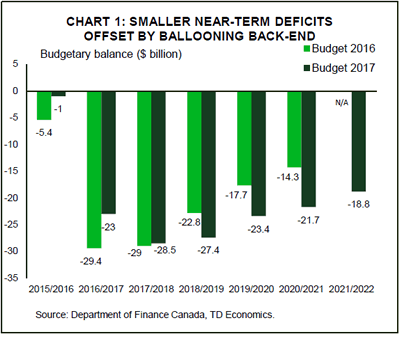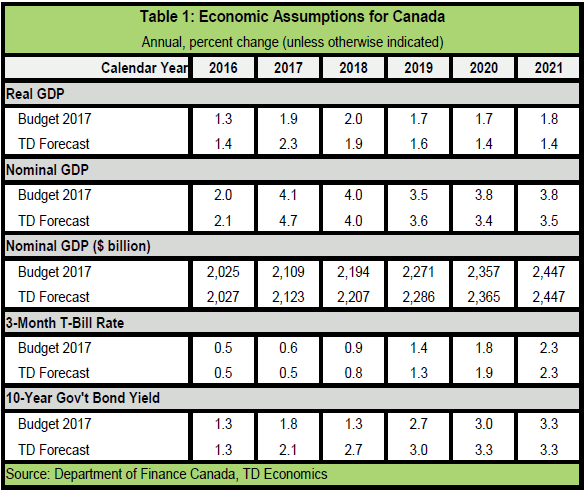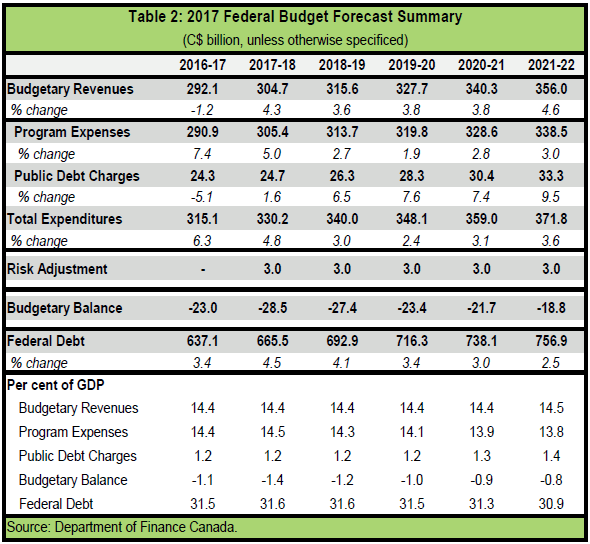Highlights
- The government expects to run a deficit of $28.5 billion (about 1.3% of GDP) in the coming fiscal year, roughly in line with 2016 budget projections.
- Deficits continue over the forecast horizon, declining somewhat in size. The result is a level of federal debt expected to settle around 31% of GDP by fiscal 2021.
- Digging into the details revealed a largely business as usual budget, focused on continuing to implement the sizeable promises made in Budget 2016. Only $4.4 billion in net new spending is planned over a five year horizon.
- Notable by their absence were any major changes to the tax system. Small tweaks were made around the edges, but the capital gains inclusion rate was left untouched, as were other major tax rates.
- While some might have been hoping for significant changes in policy, the cautious approach shown today appears warranted. Big spending measures from last year still need to be implemented, while global and domestic economic uncertainty remains elevated.
Last year’s budget was a big bang on tax and spend initiatives. This year, not so much. The government announced a net $4.4 billion in new initiatives over a five year period. For comparison, this is roughly one-fifth the amount announced last year, spread over a longer timeframe. Hot-button issues, such as changes to the capital gains tax and the potential sale of airports, were not acted upon. This budget was more about trimming the edges on labour market and tax inefficiencies. By applying conservative assumptions on economic growth, the government shows a debt-to-GDP ratio that holds steady, edging down only modestly from 31.5% to 30.9% by 2021/22. This is a market-neutral budget, with nothing of note to rattle financial markets.
Just a bit more borrowing
The near term outlook for the federal deficit has improved (Chart 1), with a budgetary balance of -$23 billion forecast for the current fiscal year. Relative to what was presented in last year’s 5-year plan, slightly wider deficits are projected in Budget 2017, resulting in a modest $6.4 billion in net additional borrowing over the 2015/16 to 2020/21 period.

Underpinning these projections are more conservative assumptions on the future pace of economic growth. This stems from the use of a somewhat outdated survey (from December 2016; Table 1), which doesn’t capture the significant improvement in the near-term economic outlook, and thus likely overstates the near-term deficit outlook. Conversely, the December survey does appear to better reflect the medium-term growth headwinds facing Canada, presenting a lower long-term growth profile than that used in Budget 2016.

Even this slower profile does not fully reflect the longerterm headwinds facing Canada. TD Economics remains of the view that growth is likely to trend closer to 1.4% in coming years, creating a potential fiscal headwind. Perhaps reflecting this, the government has reintroduced a ‘risk adjustment’, adding $3 billion per year to the projected deficit from fiscal 2017/18 onwards. This, in combination with the government’s growth outlook, suggests that near-term deficits may come in smaller than what has been indicated today.
Persistent deficits
A largely unchanged deficit outlook means that there remains nothing but red ink on the horizon. The size of the deficits are fairly small in the grand scheme of things, and the federal debt-to-GDP ratio is set to stabilize through time, settling at around 31% of GDP by fiscal 2021-22 (Table 2). Despite this, gone from today’s budget are explicit references to a target level of the debt ratio. While the best fiscal anchor could be debated (we would suggest a modestly declining debt-to-GDP ratio as a reasonable target), having a fiscal anchor, whatever it may be, provides reassurances to markets that some form of fiscal restraint is in place. A return to an explicit anchor would thus be a welcome development.

Spending what was planned
Today’s budget is largely focused on implementing existing promises. The government made significant spending commitments in key areas such as housing, but the bulk of the funds allocated are back-end-loaded. The rubber hits the road over the five year fiscal horizon, where only $5.2 billion in net new spending was introduced in today’s budget, as the impact of newly announced measures were offset by shifting funds from other areas. For instance, the government announced $6.6 billion in planned spending to support skills and innovation. But, once the reshuffling of pre-existing commitments is taken into account, the net impact on the deficit is expected to be $2.9 billion. In some areas, the government has actually reduced its planned spending (on net) over the near-term horizon. These include what the government calls "Communities Built for Change", such as infrastructure spending, early learning and childcare initiatives, and indigenous communities.
When it comes to existing spending commitments, the government provided an indication of progress to date. Most major areas are reported to be largely on track (in terms of Budget 2016 commitments), with the exception of infrastructure spending, where only 50% to 75% of projects are reported to be on track. From an economic growth perspective, even this statistic may be somewhat misleading, as it tracks cash disbursements, not shovels in the ground. Indeed, data from Infrastructure Canada indicates that only a small fraction of projects approved since the time of last year’s budget have actually begun construction. Thus TD Economics remains of the view that the majority of the growth impact from existing spending commitments is yet to come, and will extend into 2018 given delays already observed.
Nothing comprehensive, but some tax tweaks in the offing
The federal government had been planning a comprehensive tax expenditure review, but it was not to be found in today’s budget. Nor were changes to the inclusion rate for capital gains, or the treatment of stock option compensation. Still, many tweaks around the edges were brought into play. Key among these:
- Elimination of the public transit tax credit
- The tax credit for oil and gas exploration is being tweaked to gradually decline over time, rather than deducted immediately
- The alcohol tax will be nudged up immediately, and continue to increase in line with the pace of consumer inflation.
- The definition of a taxi service is to be changed such that ridesharing services such as Uber are taxed in the same way as traditional taxi services.
- Last year’s increase in CRA vigilance will be met with a further budget increase aimed at cracking down on tax evasion.
The cautious approach to the tax system shown today is likely warranted in light of the significant uncertainty emanating from south of the border. Discussions and negotiations are underway that could result in significant reductions in U.S. corporate tax burdens, impacting Canada’s current competitive advantage. At the same time, it would have been unusual to see significant changes around capital gains or stock options as part of a budget focused on innovation. Ultimately though, while caution was today’s watchword, this is not the end of the story. It would hardly be surprising to see the tax system revisited once there is more certainty around Canada’s relative competitiveness on this front.
Innovation a focus
As was communicated heading into the budget, a significant portion of the document was devoted to Canadian innovation. Measures included funds aimed at supporting innovation "superclusters", the creation of a "Strategic Innovation Fund" that consolidates and expands a number of existing funds and initiatives, and spending to support Clean- Tech and AgTech development. A focus was also placed on support for skills training. A welcome development is a change to the EI qualification system, allowing EI recipients to pursue education without losing their EI payments.
Potential market reaction
Ahead of the budget, rumours were swirling around potential tax changes – particularly the treatment of capital gains. In the event, no major changes were in the offing, with the changes that were put in place generally consisting of minor tweaks. As a result, it is unlikely that today’s budget will have any meaningful market impact.
The theme of minor tweaks extends to the debt management strategy. Reflecting the modest spending commitments, gross bond issuance is expected to reach $142 billion in fiscal 2017-18, an increase of $7 billion from the year prior. The focus is likely to remain again on shorter-term debt (2-, 3-, and 5-year bonds), and no changes to the target maturity pattern or benchmark sizes are planned. There is no explicit plan, but the government again indicated a willingness to issue ultra-long maturity bonds on a ‘tactical’ basis.
Bottom Line
Ultimately, what the government delivered felt more like a fiscal update than a budget. Little was on offer in terms of new spending, while at the same time much of the concern around significant tax changes proved misplaced. This lack of excitement may not be a bad thing. The economic landscape remains shrouded by uncertainty, presenting a strong case for today’s wait and see approach.













